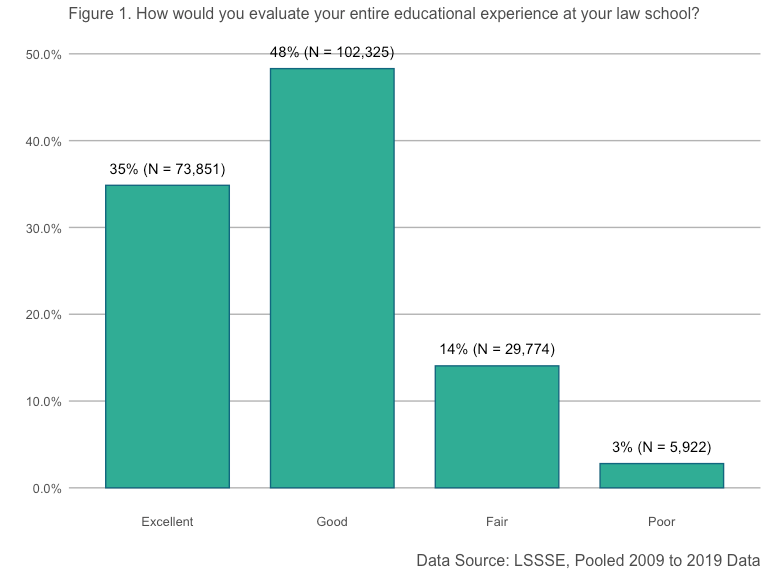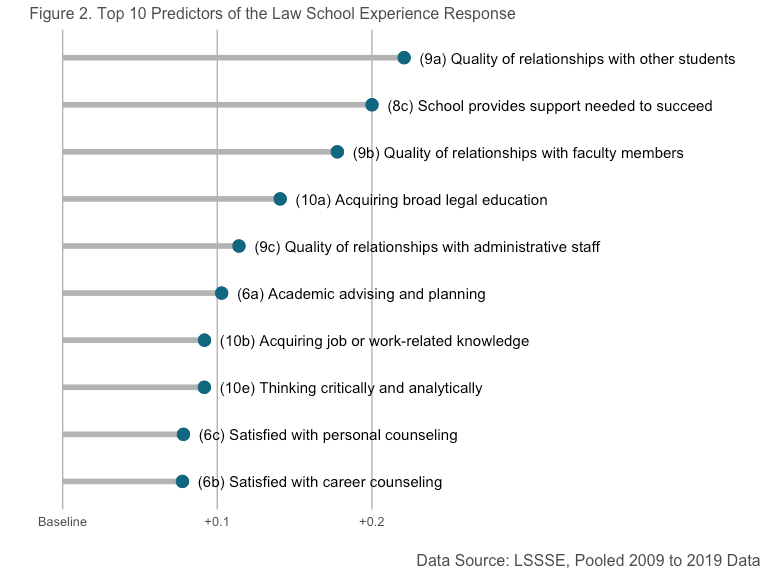 Evan Parker, PhD
Evan Parker, PhD
Founder
Parker Analytics, LLC
Law school administrators operate in an environment that Dean Camille A. Nelson calls “relentlessly competitive” (See Nelson, “Towards Data-Driven Deaning,” LSSSE, August 22, 2019.) With students taking on sizable debt and an increasingly uncertain legal job market, it’s more important than ever that school administrators and faculty find ways to maximize the value of the law school experience.
What should they do to maximize the student experience? Conveniently, we can ask the students. More precisely, we can study students’ views of their law school experience as captured by the Law School Survey of Student Engagement (LSSSE). One question on the survey asks, “How would you evaluate your entire educational experience at your law school?” LSSSE participants respond with one of four options: Excellent, Good, Fair, or Poor. Using a statistical model, we can identify what factors most strongly differentiate students who say their experience in law school was “Excellent.”
As a rich professional survey with extensive coverage of student issues, LSSSE lets us examine a number of possible drivers of student satisfaction with law school, and highlight those factors that seem to matter the most. I view this as evidence into what students want—and thus, what administrators looking to maximize value should work hard to deliver.
In the analysis to follow, the factors that most strongly predict an “Excellent” response—the top “value differentiators”—are within reach of every law school administrator, albeit addressing these factors requires hard work. In broad terms, this student-driven data indicates that schools must do three things well:
- Build and sustain relationships among students, faculty and professional staff;
- Provide first-rate advising, career counseling and personal support; and
- Develop a broad curriculum that instills work-related knowledge.
Analyzing the Law School Experience
In this analysis, we’ll consider pooled LSSSE data over the 2009 to 2019 period. Figure 1 reports the four responses to the “entire experience” question, illustrating the distribution in percentage terms. Number of students per response is listed in parentheses.

Over the past decade, about one-third of LSSSE participants said that their entire law school experience was “Excellent” (35%). A near-majority of students viewed their law school experience as “Good” (48%), and the remainder were less positive (Fair = 14%, Poor = 3%).
We can use a statistical model to identify factors that are most strongly associated with an excellent law school experience. With more than 60,000 complete survey responses (i.e., 60,000 surveys have complete data), it’s straightforward to perform an exploratory analysis—one that includes all possible inputs into the model using the standard battery of LSSSE questions, 2009 to 2019—82 questions in total.[1] In a sample this large, the fact the model returns information about “statistical significance” is not so meaningful, since most of the factors will reach a level of significance. What is meaningful in the model, however, is its ability to produce “appropriate comparisons” between types of students—comparisons which isolate the importance of specific LSSSE factors by revealing the expected differences in students’ perceived law school experiences. For the purpose of this post, we’ll compare student responses that are typical (at the mean) versus responses that are very favorable (+2 standard deviations above the mean), and all else equal.
Figure 2 reports the top 10 positive predictors of the law school experience response. Reported values are the model-based differences between a typical baseline response (mean) and a very favorable (mean +2 s.d.) Scanning across the items, the three general themes involve (1) interpersonal relationships, (2) perceptions of support, and (3) features of the law school curriculum.

Quality of Relationships. The strongest positive differentiator is question (9a), the quality of relationships with other students. On this item, LSSSE asks students whether their relationships with other students are unfriendly or friendly using a 1 to 7 scale. So, at schools where students report above average friendliness among their peers, they are also more likely to view their law school experience as excellent. The same is true for relationships with faculty (9b) and administrative staff (9c), who are evaluated in terms of their availability and helpfulness, respectively.
Counseling and Support. A second set of factors that are strongly positively related pertain to students’ perceptions of support. This is the case in general per the importance of (8c), about the school’s ability to provide necessary support to succeed (1 = Very Little, 4 = Very Much). It’s also the case with academic advising (6a), personal counseling (6c), and career counseling (6b). Perhaps not surprisingly, the quality of a school’s advising and support functions matters a great deal to students.
Law School Curriculum. A final set of factors pertain to the nature of the curriculum. Students who most strongly believed they had acquired a broad legal education (10a) along with job or work-related knowledge (10b), and were taught to think critically and analytically (10b), were those who were most likely to give their law school an overall rating of “Excellent.”
What Students Want
With this short analysis, we see the value in leveraging the student perspective to focus the efforts of law school decision-makers. Students want to attend a school where relationships with other students, faculty and staff are both possible and enjoyable. For Deans, this might mean giving more weight to social functions and community-building activities than they have in the past. Students also want a sense their school is supportive, and working toward their success by providing resources to aid in both academic and personal decisions. They find greatest value when the law school curriculum equips them with skills they will need in practice. At the end of the day, “the ask” seems reasonable on its face.
___
[1] The model is a linear mixed effects regression that accounts for law school class year, survey year, and unique law school effects. More sophisticated models are certainly possible (e.g., an ordinal response model), yet in my exploration I’ve found that the conclusions shared here end up the same regardless.
